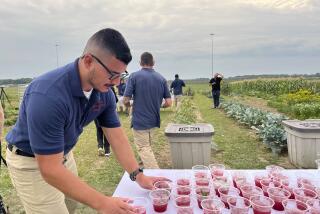School Dishes Up Jobs for Homeless
The lunch hour is fast approaching and culinary student Ruben Rodriguez swiftly stirs a spicy Sicilian sauce.
His teacher sips a spoonful: Needs more pepper. Rodriguez grabs an oversized can of the spice, delivers two blasts and stirs, stirs, stirs. There isn’t much time.
Soon more than 100 people--poor, homeless and hungry for a hot meal--will line up outside the Ventura County Rescue Mission in Oxnard for heaping plates of the food Rodriguez is preparing.
It’s a line Rodriguez stood in less than four months ago, after 15 years of being strung out on heroin or locked in jail. He checked himself into the shelter’s recovery program last fall and enrolled in this culinary school, which is teaching him the basics of cooking and catering.
“I love cooking, but I never thought I could make it a profession,” said Rodriguez, 39. “I am learning to stand on my own feet as a man.”
Dozens of men--once homeless, jobless and hopeless--have graduated from the school since it began in 1998. Many are now employed by catering companies, or in oil-rig galleys, hotels or restaurants.
The school is part of a nationwide trend to pair soup kitchens with programs that equip meal recipients with culinary skills. The idea is to provide food for the hungry and, at the same time, sustenance for broken lives.
One of the first programs was DC Central Kitchen in Washington, D.C., which director Robert Egger started in 1989. Since then, at least 65 similar programs have cropped up in 58 cities--from New York to Portland, Ore. They exist in Burbank, San Francisco and Sacramento.
“It works because people feel like they’re part of a team. We bring them in and tell them, ‘If you help us feed the city, we’ll get you a good job,’” Egger said. “What separates these kitchens from other job training programs around the country is that they have made the big mission a training opportunity.”
Tomas Cassia, founder and director of the Oxnard program, saw that opportunity when he arrived at the mission to interview for a job running the kitchen.
“When I first came here, they were serving soup and sandwiches,” he said. “I thought, ‘We can do something better for them.’ ”
On a recent weekday, the soup kitchen’s main course for lunch is fillet of fish topped with Rodriguez’s Sicilian sauce--a crimson concoction of tomatoes, peppers, onions and garlic. On the side are salad, a hearty rice-and-pasta dish and a pile of steamed mixed vegetables. Dessert is freshly baked chocolate-chip cookies.
For dinner, the entree is Cajun jambalaya.
“Every day we serve quality food,” said Cassia. “Many times we have better food here than at my house,” he added with a smile.
Cassia compiles the menus each morning, depending on what has been donated to the mission that week by families, churches and local businesses.
All the recipes are Cassia’s own, and everything in the mission kitchen is made from scratch. A 12-man crew--some of them in the kitchen at 6 a.m.--spends hours peeling, chopping, boiling and baking.
“I joke that I am the only chef who serves 1,000 meals a day and receives no complaints,” Cassia said.
At noon, when people file into the cafeteria, Cassia’s students take their places. Wearing white chef hats and blue aprons, they load up tray after tray until everyone is fed.
When lunch service ends, the culinary school day is far from over. After washing dishes and scouring the stainless-steel equipment, the students head to class.
Throughout the six-month program, Cassia and the mission’s executive chef, Mike Lodi, teach courses on everything from setting tables for a banquet to preparing pastry dough.
Today, it’s a class on food safety, such as proper handling of raw meat. At the end of the weeklong lesson, the students will take a test furnished by the National Restaurant Assn. that will give successful students a certification card good for three years, Lodi said. Many restaurants require that employees be certified in food safety.
The school is also affiliated with the Channel Islands Chefs Assn., a chapter of the American Culinary Federation--the nation’s oldest and largest organization of chefs and cooks.
Chapter President Eric Olson, executive chef at the Ojai Valley Inn, has hired several of Cassia’s students to work during busy holiday periods, when many restaurants and catering companies need extra hands.
“The men I’ve worked with have been great,” he said. “And I know the guys who are in charge are doing a heck of a job.”
Aside from feeding 1,000 people daily at the mission and in local parks, the crew puts on banquets and caters special events on occasion.
Last week, the school hosted the chefs association’s monthly dinner.
Cassia did not want to interfere with the daily dinner service at the soup kitchen, so he partnered with Valley Spuds, an Oxnard-based potato and vegetable supplier. He and his crew transformed the company’s chilly processing warehouse into a dining room and served a seven-course gourmet meal to about 30 of the county’s top chefs and restaurateurs.
To fit the setting, each dish highlighted the potato--from salmon potato puffs to grilled fillet mignon in a bed of fried potatoes, to potato crepes with fruit and ice cream.
Valley Spuds donated much of the food, and because of the mission’s limited resources, Cassia covered the rest from his pocket.
“These people have done so much for us,” he said. “I didn’t want to present them with a lousy dinner.”
The food got rave reviews.
“The work Tomas has these guys doing is absolutely incredible,” said Harry Brockwell, a retired chef who is active in several industry associations. “Fellas who six months ago had no direction are doing fine culinary work that is hard to find in many kitchens today.”
Cassia dreams of expanding his program, and has applied for a $200,000 grant from the state’s Economic Development Department to pay for better equipment and vehicles to transport cooks to and from jobs.
For now, he said, lack of money and staff prevents him from teaching much more than the basics.
“But to me,” he said, “it is more than enough to have a new start.”
It was certainly enough for 47-year-old Armando Rivera. The Oxnard man graduated from the culinary program a year and a half ago, and now works for three companies, including Buenaventura Catering Co., one of the county’s largest caterers.
Just two years ago, Rivera was scouring the streets for his next drug fix. When he first arrived at the mission, his jaw was wired shut from a fight the night before.
Now, on his days off, he returns to volunteer in the rescue mission’s kitchen. He likes being an example for men still in the program, he said.
“I had no future,” Rivera said. “This place is a miracle for me.”
Each student in Cassia’s school also takes part in the mission’s 12-month drug and alcohol recovery program, which is grounded in spirituality. Candidates must be in that program for 30 days before Cassia will allow them into the culinary school.
“We invest a lot of money in them, so we can’t take someone who just came for a place to stay and is waiting for better weather,” he said.
The school has turned out several success stories, but the process is not always easy. Most graduates end up with jobs in the food service industry, but sometimes a graduate will revert to his old habits. Others stay clean but struggle to make overdue child-support payments, obtain driver’s licenses or find affordable housing.
Lately, Cassia has worked closely with Universal Sodexho, a company that provides support services to the oil rigs off the Ventura County coast. Several recent graduates have been hired by the company’s catering operation to cook for employees on the rigs.
Those jobs provide the men with shelter, food and clothing while they make between $8 and $12 an hour, giving them time to save money and get on their feet again, Cassia said.
Lee Thurmond, 39, worked as the executive steward--equivalent to an executive chef--on one of the oil platforms for five months. He helped feed about 30 people three meals daily--everything from chorizo and eggs to salmon steaks in sesame oil. Many of the recipes came from his training at the rescue mission.
Thurmond battled alcoholism for years, and was homeless for a month before he enrolled in the culinary school. Though he had toiled in plenty of kitchens over the years, he said he never understood the business of running one.
“Tomas and Mike taught me all the valuable things I needed to be successful and to maintain a position here in the industry,” said Thurmond, who now lives part time in Oxnard.
For information about donating to the Ventura County Rescue Mission, call (805) 487-1234.


